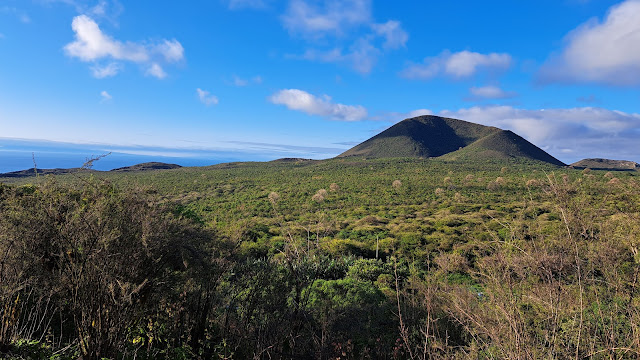Ecuador's only official postal service
It was a rough southern crossing from Puerto Ayora, and the Gravol did the trick, waves turned soothing and calm under the boat. In the early hours of morning, the anchor dropped and I drifted back to sleep. The sky lightened and I peeked up to catch a glimpse of the outside world and found our boat in an entirely different landscape. Travelling at night and waking up in the bay of a new island every morning is a luxury I’ve never known! Behold, Floreana.
At 8 am, the dinghy was loaded up for our first shore excursion. On the way, our first Blue-footed Boobies preened on the cliffs, unfazed at our approach. Sea lions basked on shore and Sally Lightfoot Crabs scrambled across the black rocks. It was a wet landing - exit the dinghy by twirling over the edge, dropping both feet in the shallow water at once, pushing up onto the sandy beach. A midden of skeletons and shells marked the start of the trail, at the end of which emerged a salty lagoon and a lone flamingo digging around for crustaceans, and we watched in silence. We passed leatherleaf shrubs, incense trees bare and waiting for rain, lichen dripping off every branch. Alone on this isolated island, I felt the reverence of stepping into an ancient cathedral and holding my breath.
 |
| Photo: Sandie Young |
Slipping into a wetsuit (sarcastic), we travelled to a rocky shoal around a smaller island, or “rock” as the hundreds of these scattered throughout the Galápagos are known. I was nervous about snorkelling - I have a moderate fear (healthy respect?) of whales, which tends to extend to other ocean-dwelling mammals. While I was excited to see the sea lions frolicking, I wasn’t sure how I’d feel swimming with them. First hopping in the water, the cold and nerves took my breath away and I forgot to breathe through the snorkel. Mildly panicking, it took a moment to calm down and get used to the water, but eventually the fish were irresistible. The first I noticed were the miniscule school passing right before my goggles, but I started to pay attention to the large and colourful species around me.
The first sea lion darted past me and my FitBit buzzed a heart rate warning, but I was ok! Exhilarated, I popped above the water to scurry back to the safety of Omar, our snorkelling-pro guide. He dove through great schools of fish and pointed out his favourites. It was a great first snorkel with many more to come. I didn’t realise I was cold until I got back to my room and noticed my skin was purple, wondering when I got this weird sunburn.
Ecuador no longer has a governmental postal service. But on Floreana Island, there is a 200 year old post office that operates without stamps. It was established as a way for whalers to trade news and send messages home on passing ships, and the tradition has continued. Inside were dozens of postcards. After Omar marked them with his custom designed Post Office Bay stamp on the slab of rock placed like a post office desk beside the rotting barrel, I dropped my three postcards for delivery. Together, our group sifted through to find cards addressed near our hometowns. I decided to take home three: one in Toronto, one in Woodstock, and a little ambitiously, one in Coburg. Tradition dictates that you deliver by hand and tell the recipient you picked it up in the Galápagos for them. As of writing, I have already delivered my Toronto card. Jill was thrilled to receive it only a few weeks after having deposited it herself at Post Office Bay. Enamoured by this tradition, we both gushed about our trips and enjoyed this opportunity to participate.
 |
| Photo: Omar Medina |
In the afternoon, the Reina Silvia voyaged around the island to the town where 147 people live. After admiring red-hued marine iguanas along the rocks and a family of sea lions basking on the dock stairs, we boarded an open-air truck with a few rows of benches like church pews and careened up to the highlands. Up there, the landscape was lush with forest-covered volcanoes and the glimmering ocean in the background. At the top, there was a rocky hike passing Floreana’s secluded hybrid tortoises, destined to live out their long lives unable to migrate to the lowlands to reproduce - their dubious ancestry would pollute the genetics. Restoration is in progress with a pair of Floreana tortoises that were encountered misplaced by whalers on Isabela. Up we travelled to a trickling stream of rare freshwater, which had drawn whalers and settlers to Floreana for centuries. Here Omar recounted the sordid tale of the Ritters, Wittmers, and the Baroness. For those interested, see Satan Comes to Eden.
With a spectacular ride back down to town, admiring the ocean view over the volcanoes, we set our sights on the Wittmer Hotel to greet Margaret’s great-granddaughter, enjoying a beer watching a spectacular sunset. It was so picturesque and tropical, and easy to see why those families called it their Eden.
 |
| Photo: Omar Medina |
 |
| Photo: Omar Medina |
Tipsy on the dinghy ride, it was a fun return just in time for our official meeting with the crew. There were ten wonderful people on the Reina Silvia keeping us afloat and catching snippets of the World Cup as we travelled. We had our chefs, Daniel and David, Mariuxi and Manuel upfront, sailing crew Alex, Cristian, Diego, Enrique, and Nico, and El Capitan Cirilo Luna. We were in great hands!










Comments
Post a Comment